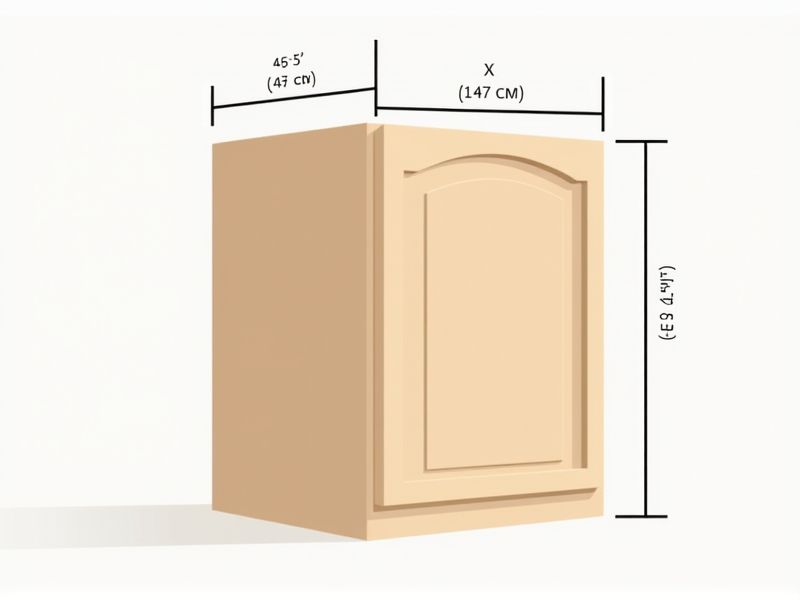
When planning for a pantry cabinet, knowing the standard dimensions can help you make the best use of your available space. Typically, a standard pantry cabinet is 24 inches deep and ranges from 12 to 36 inches wide. The height can vary, but most pantry cabinets are 84, 90, or 96 inches tall to match common kitchen layouts. Choosing a cabinet within these dimensions ensures compatibility with most kitchen designs and maximizes storage efficiency.
Total Height: 84, 90, Or 96 Inches
The standard total height of pantry cabinets typically ranges from 84 to 96 inches, allowing for versatile storage solutions in various kitchen designs. Many homeowners prefer the 90-inch option for a balance between accessibility and maximizing vertical space. When selecting a pantry cabinet, consider that taller cabinets can help you utilize every inch of available space, especially in kitchens with higher ceilings. Your choice of height can significantly impact organization, ensuring ample room for food items and kitchen supplies.
Width: Typically 12 To 36 Inches
A pantry cabinet usually ranges in width from 12 to 36 inches, allowing for versatility in various kitchen layouts. Depths typically vary between 24 to 30 inches, while heights can reach up to 84 inches or more for maximum storage. Depending on your needs, you may choose between different configurations, including adjustable shelves or pull-out drawers. Selecting the right width for your pantry cabinet ensures optimal organization and efficient use of space in your kitchen.
Depth: Standard 12 Or 24 Inches
Pantry cabinets typically come in two standard depths: 12 inches and 24 inches, catering to various space needs and storage requirements. A 12-inch depth is ideal for tighter spaces, allowing you to store smaller items like spices and canned goods efficiently. In contrast, a 24-inch depth offers enhanced storage capacity, providing ample space for larger bulk items or pantry essentials. Choosing the right depth not only maximizes your kitchen's functionality but also enhances overall organization.
Shelf Spacing: Adjustable Or Fixed At 3 Inches
Pantry cabinets typically feature shelf spacing options that can be either adjustable or fixed, with common intervals set at 3 inches. Adjustable shelves offer flexibility, allowing you to customize the height according to your storage needs, which can accommodate various pantry items, from canned goods to baking supplies. On the other hand, fixed shelves provide stable support for heavy items, ensuring reliable organization. When planning your pantry, consider the optimal shelf spacing to maximize space efficiency and improve accessibility.
Unit Configuration: Single Or Double Door
Pantry cabinets are available in two primary unit configurations: single or double door. A single door pantry cabinet typically features a compact design, ideal for smaller spaces, offering efficient storage without occupying too much floor area. In contrast, a double door pantry cabinet provides greater accessibility and storage options, often including multiple shelves and compartments that maximize organization potential. Your choice between these configurations will depend on your kitchen layout and storage needs, with dimensions usually ranging from 24 inches to 36 inches in width.
Material Composition: Solid Wood, Plywood, Or Mdf
The standard for pantry cabinets primarily emphasizes material composition, with solid wood, plywood, and MDF being the most common options. Solid wood offers durability and a classic aesthetic, while plywood, made of thin layers of wood, provides excellent strength and resistance to warping. MDF, or medium-density fiberboard, is an affordable choice that allows for intricate designs due to its smooth surface. When selecting a pantry cabinet, consider that solid wood typically ranges from $100 to $500, plywood from $75 to $300, and MDF from $50 to $200, depending on quality and finish.
Interior Finish: Natural Wood, Painted, Or Laminated
The standard of pantry cabinets emphasizes various interior finishes that enhance aesthetics and durability, including natural wood, which offers a classic and rich appearance. Painted finishes provide a versatile option, allowing you to match your kitchen's decor with an array of color choices. Laminated finishes ensure a low-maintenance solution, resistant to scratches and moisture, ideal for high-traffic areas. Selecting the right finish can elevate the overall look and funcionality of your kitchen space.
Door Style: Flat Panel, Raised Panel, Or Glass Inserts
Pantry cabinets are available in three primary door styles: flat panel, raised panel, and glass inserts. Flat panel doors provide a sleek, modern appearance, often favored in minimalist kitchens, while raised panel doors offer a more traditional look with depth and dimension. Glass inserts can add visual interest and allow you to showcase your dishware, enhancing the overall aesthetic of your space. When selecting a door style, consider how it complements your existing kitchen design and your personal preferences.
Hardware: Knobs, Pulls, Soft-Close Hinges
Upgrading your pantry cabinet with high-quality hardware can significantly enhance both function and aesthetics. Opt for durable knobs and pulls made from materials like brushed nickel or matte black, which add a modern touch while ensuring longevity. Incorporating soft-close hinges is essential, as they provide a quiet, gentle closing action that protects your cabinetry and prevents slamming. Investing in these hardware elements not only improves the user experience but can also add value to your kitchen space.
Base Support: Toe-Kick Or Adjustable Legs
The standard pantry cabinet typically features a toe-kick height of 4 inches, providing a seamless look while allowing you to easily clean underneath. Adjustable legs can range from 4 inches to 6 inches in height, accommodating uneven floors and ensuring stability. This flexibility enhances your ability to install the cabinet in various configurations, making it more user-friendly. For optimal organization, consider incorporating adjustable shelves that can hold up to 100 pounds, allowing you to maximize your storage space effectively.
